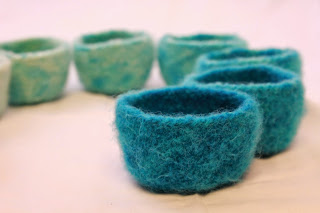I made Flower in February and March of 2014, knitting a lot of it during class (it was a favorite topic of discussion in my Indigenous Literature and Film class) and finishing it on a road trip to Portland, Oregon that my fiance and I took over spring break. I've been meaning to make another squid for awhile, and bought the yarn for it several months ago. I just got around to it this past week, knowing I would have lots of knitting time as my fiance and I took a week off to drive up to the north shore of Lake Superior for some camping.
We ended up cutting the trip a bit short (but still taking the whole week off) because we were both feeling anxious to get back to our place and work on getting things moved and organized. This is when I happened to discover a little issue with my first squid.
During my move, I packed Flower into a garbage bag along with some other knitted animals (like a Big Snowy Owl that still needs eyes and a beak) and when I finally got around to opening the bag, I noticed a familiar unpleasant smell.
Cat pee.
As it turns out, my cat peed on Flower's poor, unsuspecting squid head at some point - I kept the squid on top on my bookshelf which my kitty Alaska liked to hang on and around. She isn't usually one for peeing on things, so I'm still a bit confused as to why, but that's cats for you.
 |
| She's too cute and fluffy for me to stay mad at. |
This afternoon, I apprehensively put her in the washing machine on the most gentle wash and spin cycle settings, keeping my fingers crossed that my poor squid baby wouldn't come out mangled.
 She survived the wash, getting a bit misshapen in the process but otherwise looking (and smelling!) so fresh (and so clean, clean) and I decided the dryer might be a good idea as well, especially considering that it has a delicate cycle and extra low heat option.
She survived the wash, getting a bit misshapen in the process but otherwise looking (and smelling!) so fresh (and so clean, clean) and I decided the dryer might be a good idea as well, especially considering that it has a delicate cycle and extra low heat option.
Now that she's clean and mostly dry, I set her up to dry on top of my mannequin because it was the perfect size to fit her underside on so she can dry nicely. It also has the added advantage of making her look like Octodad.
I've made some pretty serious progress with Squid #2 the past week, with all eight arms finally done.
Which is good, because I think I might have lost my mind if I had to knit one more of those damn bobbles. I made the underside last night, and am now dreading all of the seaming on the arms, because seaming is more or less my arch knitting nemesis. I think in the end my motivation to finish Squid #2 (think of all of the squid cuddling possibilities!) will let me power through the rest of the pattern... wish me luck!

















